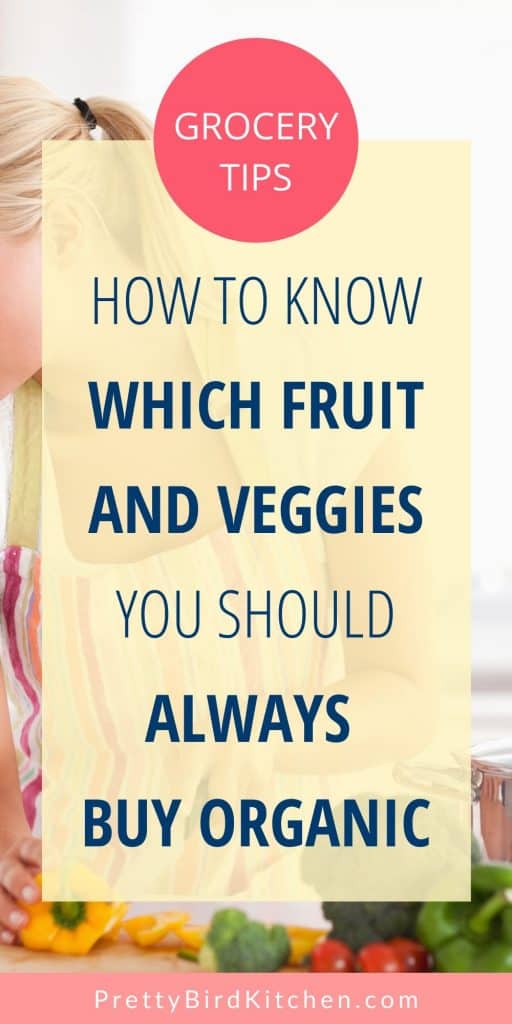The Dirty Dozen and Clean Fifteen (Free Printable List!)
Learn all about the Dirty Dozen and Clean Fifteen, plus get a free printable list to keep for easy reference! I’ll show you which foods have the most pesticide residues according to the Environmental Working Group and which ones have the least amount of chemicals so you know which fruits and vegetables you should buy organic and which ones are okay to buy non-organic.

This post may contain affiliate links. See my full disclosure here.
Do you know which foods are most important to buy organic?
Do you know which foods you don’t need to buy organic?
It can be hard to make sense of it all, especially now that grocery stores are overflowing with both kinds of produce. Luckily, the Environmental Working Group publishes two annually-updated lists of foods you should buy organic and foods that are okay to buy non-organic to help cut through all the noise and clever marketing.
These handy lists are called the Dirty Dozen and the Clean Fifteen.
- The Dirty Dozen is a list of foods that have higher pesticide residues. If you can afford it, it’s best to buy these foods organic.
- The Clean Fifteen is a list of foods that have lower pesticide residues. These are okay to buy non-organic.
Let me tell you about each one so you can buy the healthiest produce possible AND get the biggest bang for your buck at the grocery store.
Related: How to Afford a Plant-Based Diet on a Budget
The Dirty Dozen 2020
Back to my first question: Do you know which foods are most important to buy organic?
Ideally, the foods with the most pesticide residues are the ones you want to buy organic so you can avoid as many harmful chemicals as possible. You can use The Environmental Working Group’s Dirty Dozen list to help you decide which foods to buy organic. The fruits and vegetables on this list include:
- Strawberries
- Spinach
- Kale
- Nectarines
- Apples
- Grapes
- Peaches
- Cherries
- Pears
- Tomatoes
- Celery
- Potatoes
- Bonus: Hot peppers
The Clean Fifteen 2020

What about my second question: Do you know which foods you don’t need to buy organic?
Believe it or not, some organic foods aren’t worth the money because the non-organic versions don’t have a lot of pesticide residues on them. You can use the Clean Fifteen to determine which non-organic foods are safe to eat. The fruits and vegetables on this list include:
- Avocados
- Sweet corn
- Pineapple
- Onions
- Papaya
- Sweet peas, frozen
- Eggplant
- Asparagus
- Cauliflower
- Cantaloupe
- Broccoli
- Mushrooms
- Cabbage
- Honeydew melon
- Kiwi
The Full List: EWG’s 2020 Shopper’s Guide to Pesticides in Produce
The Environmental Working Group actually tests 47 popular fruits and vegetables for pesticide residues, although many of them don’t show up in the official Dirty Dozen and Clean Fifteen ranks. However, they do have a full list with all of those fruits and vegetables listed in the order of dirtiest (most pesticide residues) to cleanest (least pesticide residues).
Here are all 47 of them:
- Strawberries
- Spinach
- Kale
- Nectarines
- Apples
- Grapes
- Peaches
- Cherries
- Pears
- Tomatoes
- Celery
- Potatoes
- Sweet bell peppers
- Cherry tomatoes
- Lettuce
- Cucumbers
- Blueberries
- Hot peppers
- Plums
- Green beans
- Tangerines
- Raspberries
- Grapefruit
- Snap peas
- Winter squashes
- Carrots
- Oranges
- Summer squashes
- Bananas
- Sweet potatoes
- Watermelon
- Mangoes
- Kiwi
- Honeydew melon
- Cabbage
- Mushrooms
- Broccoli
- Cantaloupe
- Cauliflower
- Asparagus
- Eggplant
- Sweet peas, frozen
- Papaya
- Onions
- Pineapple
- Sweet corn
- Avocados
The EWG also has a note at the end of this list stating that “a small amount of sweet corn, papaya and summer squash sold in the United States is produced from genetically modified seeds. Buy organic varieties of these crops if you want to avoid genetically modified produce.” (source)
If you’re concerned about GMOs, then definitely go with organic versions of these foods.
Free Printable Dirty Dozen and Clean Fifteen List
The Dirty Dozen and Clean Fifteen lists are super helpful when you aren’t sure which fruits and vegetables you should buy organic, which is why I like to keep a cheat sheet on hand so I don’t have to Google the lists every time I want to reference them.
If you’d like to have a pretty printable list too, you can download a copy of mine here:

FREE Dirty Dozen and Clean Fifteen cheat sheet
Use this list to buy organic where it really counts so you save money on the rest of your produce.
Final Thoughts on the Dirty Dozen and Clean Fifteen
So now you know what to buy organic in 2020! The Dirty Dozen are the foods with the most pesticide residues, so those are the ones you should buy organic if you can. But there are plenty of foods you don’t need to buy organic. The Clean Fifteen are the fruits and vegetables with the lowest pesticide residues, so those are okay to buy non-organic.
And if you don’t want to Google the Dirty Dozen and Clean Fifteen lists a million times, you can just download my free printable cheat sheet to keep on hand for easy reference!
Other Healthy Eating Articles You May Enjoy
- How to Afford a Healthy Lifestyle on a Budget
- 12 Healthy Habits You Can Start Today
- The Whole Food, Plant-Based Diet Explained
- How to Start a Plant-based Diet: The Ultimate Transition Guide for Beginners
- Plant-Based Shopping List: What to Buy When You Follow a Plant-based Diet
What about you? Do you buy all organic food, or do you let the Dirty Dozen and Clean Fifteen determine which foods you buy organic? Let me know in the comments!

Want to remember this? Save it to your favorite Pinterest board by clicking the images below!



